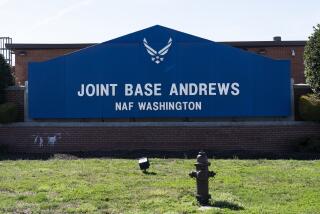Air Force Dodges Sept. 11 Flak
- Share via
The most amazing thing about the blame game now being played over who was at fault for Sept. 11 is that no one is pointing a finger at the Air Force. Amazing because it’s a lot easier to see why the FBI and the CIA were unable to connect a series of sometimes wildly divergent dots than it is to understand why the Air Force had no plan to protect the nation’s capital from an attack by terrorists in planes at a time when Washington was deluged with warnings of terrorist threats.
It is even more amazing that, nine months later, the Air Force still had no workable defense for Washington.
That was made frighteningly clear June 19 when it failed to stop an off-course single-engine plane from getting near the White House. The Cessna 182 remained within striking distance for 12 minutes, flying out before two F-16 fighters from Andrews Air Force Base, 10 miles away, took off after it. Officials said there was no way the F-16s could have stopped the pilot from hitting the executive mansion had he wanted to.
That would not have been true right after Sept. 11. The Air Force originally responded to the attacks by flying 24-hour-a-day fighter patrols over Washington. But these were dropped in recent weeks because of stricter airline security and because, at a cost of $50 million a week, they were deemed too expensive. They were replaced by random patrols and more fighters on ground alert at more bases.
Incredibly, on Sept. 11 there was not a single fighter plane on alert at Andrews because the Air Force’s North American Aerospace Defense Command did not consider an attack on the capital by terrorists in planes probable. This despite the fact that, according to Time magazine, the CIA had concluded in August that “Al Qaeda was determined to attack the U.S.” What’s a more logical U.S. target than the capital?
Instead, two F-16s had to be scrambled from a base 130 miles away. They were still 12 minutes away when American Airlines Flight 77 crashed into the Pentagon. In fact, on Sept. 11 only 14 fighter planes at just seven bases in the entire country were on ground alert for air defense, according to NORAD spokesmen.
NORAD is supposed to defend this continent against air attack from abroad. But the primary responsibility for managing the airspace over the U.S. rests with the civilian Federal Aviation Administration. The FAA telephoned NORAD after the World Trade Center had been hit twice and American Flight 77, far off course for its scheduled trip from Washington to Los Angeles, was suspiciously headed back toward the capital. But that call came too late.
Other fighters took off to intercept United Airlines Flight 93, bound from Newark to San Francisco, after it too changed course for Washington. Officials now say the hijackers planned to hit the White House, a plot thwarted when passengers forced that airliner to crash in Pennsylvania.
The Air Force’s most damaging admission is that the Sept. 11 attacks were a complete surprise.
“You hate to admit it, but we hadn’t thought about this,” confessed the chairman of the Joint Chiefs of Staff, Air Force Gen. Richard B. Myers, in an Oct. 17 interview.
Why not? Myers and other generals spend their lives war-gaming possible attacks on this country. Moreover, authorities knew as far back as 1995 that terrorists considered crashing a plane into CIA headquarters. And in July 2001, Italian officials deployed antiaircraft missiles to protect President Bush against such a threat at the Group of 8 conference in Genoa.
Given those facts, plus the history of World War II kamikaze attacks, how many more warnings did the Air Force need?
True, the FBI, CIA and National Security Agency also failed to pick up on warnings. Those agencies are being relentlessly scrutinized and criticized by Congress and the press. Not so the Air Force. There are no demands that it too be investigated.
All the Air Force had to do was heed the ample warnings that the United States was a terrorist target, reasonably conclude that Washington probably would be among the first places hit and plan an air defense.
Such a defense might not have been successful against a hijacked airliner. But not even to have imagined the possibility of such an attack, not even to have fighters alerted at Andrews, is inexcusable. Not to have an effective air defense against a small plane nine months later is even worse.
More to Read
Sign up for Essential California
The most important California stories and recommendations in your inbox every morning.
You may occasionally receive promotional content from the Los Angeles Times.













